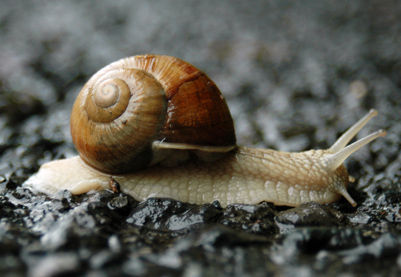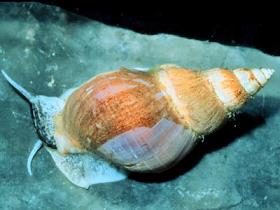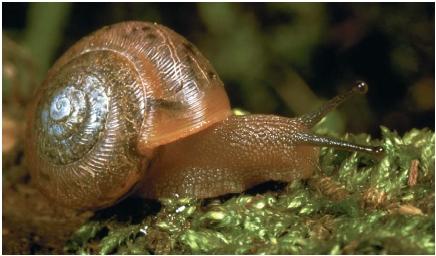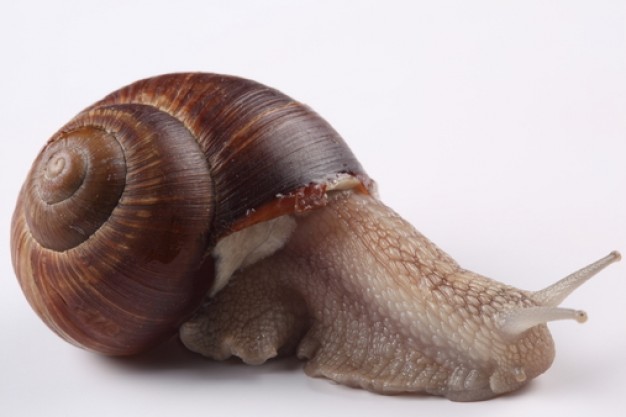
Mollusks first appeared in early Cambrian
times, 650 million years ago. They are the
second largest animal phylum, Mollusca (from
Latin mollis, "soft"). The only larger animal phylum
is Arthropoda. According to current estimates,
there are approximately 49,000 mollusk
species. All mollusks have soft, boneless bodies.
Most have shells, though some shells are poorly
developed and are even absent in some cases.
Mollusk shells are like coats of armor.
Mollusks form seven classes. Best known are
gastropods, including approximately 38,000 species
of snails and slugs; bivalves or pelecypods,
approximately 8,000 species of clams and scallops;
cephalopods, approximately 600 species of
squid and octopuses; and polyplacophora, approximately
600 species of chitons. The other
classes contain under 1 percent of mollusk species
and are not discussed.
Mollusks are present in all of earth's habitats.
However, most of them, comprising the greatest
species diversity, are in the oceans. There, the largest
number are various species of gastropods
(snails). All gastropods are univalves, possessing
one shell. Many other mollusks are the familiar
pelecypod-bivalve-mollusks (clams), which
have two shells. Mollusk bodies look undeveloped
and many lack apparent heads. However, all
have well-developed nervous, circulatory, respiratory,
and sensory systems. Except for cephalopods,
mollusks are slow-moving, sluggish, or immobile
(sessile). In many cases they spend their
adult lives attached to rocks or dug into sand or
mud, awaiting the approach of prey.
Some mollusks, mostly gastropods, occur in
freshwater and on land. For example, snails and
slugs are seen at the bottoms of ponds, rivers, and
lakes, or under fallen trees and decaying logs.
Some land snails even live in tree branches. Characteristic
features of gastropods are a true head, a
creeping surface (or foot), eyes, and tactile feelers.
The foot gives gastropods their name, which
means "foot on belly" in Latin. Most gastropods
have a univalve shell, but some species have no
shell. Others, such as garden slugs, have tiny, internal
shells.
Physical Characteristics of Mollusks
The largest mollusk is the giant squid, which is
also the largest invertebrate. It can be fifty-five feet
long and weigh several tons. Most mollusks, however,
range from0.5 to 10 inches in length and only
weigh up to a few pounds. One exception to the
size rule is the tropical giant clam, maximum diameter
4.5 feet, maximum weight five hundred
pounds.There aremanymollusk variations.
However, some features
can be generalized in mollusk
bodies, based on gastropods and
bivalves. In motile forms, locomotion
is due to crawling on
flat, muscular, snail-like feet,
though jet propulsion occurs in
cephalopods. Also, the mollusk
body has a head at one end and
an anus at the other. Furthermore,
much of the body is covered
by a shell (internalized in
cephalopods) of calcium carbonate
and protein. Shells are
made by mantle tissue. Inside a
shell is a large part of the body,
fragile parts of cardiovascular,
digestive and excretory, nervous,
reproductive, and respiratory
systems.
Mollusk shells thus function
protectively, like the rib cages and
pelvic bones of vertebrates. The
shells of bivalves are divided into
two valves, which are opened or
tightly closed by strong muscles.
These muscles must be cut in order
to open the shell for examination.
The gastropods possess one asymmetrical
shell, often of spiral shape,
into which they retreat from the
world. In cephalopods the shell is
internalized, but still yields organ
protection.
The organs and their positions
in mollusks, especially gastropods,
are as follows. At the anus end of
the body are two or more gills
(lungs in land forms) for breathing.
At the front end of the body
are jaws and a tonguelike, toothed
radula. It grinds food or procures
it by drilling into shells of prey or
ship timbers (in shipworm snails).Around the jaws are tentacles, used for sensation
in gastropods. Cephalopod tentacles are used to
capture prey. Between the radula and the anus are
the stomach and the gut. A heart, near the hind
end of the body, receives blood and sends it into
the body cavity. The mollusk nervous system-
comparable to that in fish-is composed of nerves
that surround the gut, a brain, and sense organs.
Mollusks also have kidneys and gonads.
Many mollusks are herbivores, grazing on underwater
plants. Some terrestrial gastropods,
such as slugs, eat cultivated plants and are serious
garden and agricultural pests. Scaphopoda feed
on organic matter deposited on ocean and lake
bottoms. Bivalves filter protozoa, eggs of sea animals,
and diatoms out of the water in which they
live. Many gastropods are hunter carnivores, eating
slower-moving or sessile animals, such as
other mollusks. Cephalopods are very active
predators and prey on animals such as crabs.
The Life Cycles and Senses of Mollusks
Most mollusks have separate sexes and a few exhibit
courtship behavior. With or without courtship,
mollusks usually spawn sperm and many
thousands of eggs into waters around them.
There, fertilization and development of offspring
occur. When eggs hatch, offspring undergo a larval
stage. Larvae of most mollusk species are, at
first, free-swimming, using for locomotion a ring
of cilia. Most settle to lake, ocean, or stream bottoms
as crawlers who mature into adults.
Many mature mollusks, such as oysters and
mussels, are sessile, permanently affixed to rocks.
Gastropods are capable of slow crawling on a
muscular foot. Cephalopods, such as squid and
octopuses, are an exception to the mobility rule for
mollusks. They are very mobile at all stages of
their lives. Adult cephalopods move very quickly
by expelling jets of water frommantle cavities, using
an organ called a siphon. Jets are expelled in
the direction opposite to movement. Jet propulsion
makes cephalopods the fastest-moving mollusks.
It also suits them to a life of vigorous predation. In
cephalopods, the foot differentiates to ten arms
(squid) or eight arms (octopuses) that seize prey.
In some cases, fertilization in mollusks is internal,
with protective coverings secreted around
eggs. In others, fertilization and development are
internal in females and offspring are delivered
alive, as with live-bearing snails. Slow-moving
snails and related mollusks are often hermaphrodites
(both male and female). This doubles the
number of mates available to each such organism,
and often self-fertilization occurs. Both options
have great survival value. A few species reproduce
by parthenogenesis, without fertilization.
Also, mother mollusks may protect developing
eggs, and some oysters raise their offspring
within the mantle cavity.
The mollusks live for periods ranging fromunder
a year to two years for many small to mediumsized
varieties and four to five years for some
snails and shellfish. Giant squid and giant clams
reportedly can live for over twenty-five years.
Such life spans occur only when organisms reach
old age, anuncommonsituation for wild animals.
Sensory ability varies in mollusks. Most mollusks
see poorly or not at all. However, the cephalopods
have eyes like vertebrates, complete with
lenses and retinas. Squid eyes reportedly lack eyelids
but otherwise look very much like those of
humans. Although it is not ubiquitous in mollusks,
some gastropods have well-developed abilities
to smell and find food at considerable distances.
Predators are often detected in this way,
too. Conclusive studies of intelligence have not
been carried out in mollusks. However, ability to
learn fromexperience has been claimed for cephalopods.
Beneficial and Destructive Mollusks
Mollusks are very abundant. On the benefit side,
they are important foods for bottom-feeding fish
and whales. Numerous mollusks are also valuable
foods for humans. Especially widely eaten
are clams, mussels, oysters, octopuses, and scallops.
More exotic food mollusks include land
snails. Mollusks (especially oysters) also produce
pearls, the only gems made by living organisms.
On the debit side, gastropod and cephalopod
carnivores do serious damage. Gastropods prey
on slow-moving or sessile organisms, wreaking
havoc on clam and oyster beds that provide shellfish
for human consumption. Also, cephalopods
are active predators, diminishing the sea's yield of
meats sought by humans.
Another mollusk problem is foreign invasion,
exemplified by zebra mussels (Dreissna polymorpha).
These pistachio-nut-sized European saltwater
mussel invaders were released into the
Great Lakes from the hulls of ocean-going vessels
in the late 1980's. They flourish in the Arkansas,
Hudson, Mississippi, Ohio, and Saint Lawrence
rivers. Superabundant reproduction (a female
lays a million eggs per year) yields myriad larvae
that, as adults, clog power plant and factory water
intakes, requiring costly cleanup. More problematically,
they eat microbes in the water, damaging
the lifestyles of indigenous wildlife that also use
this food. It is estimated that the mussels cost industry
and consumers over $500 million per year.
Mollusk Facts
Classification:
Kingdom: Animalia
Phylum: Mollusca (soft-bodied)
Classes: Bivalva (two-shelled, no distinct head); Cephalopoda (no
shell or internal shell, very mobile, tentacled, has head and
eyes); Gastropoda (univalve shell, moves slowly, tentacled, has
head); Polyplacophora (simple crawling mollusks or chitons);
Scaphopoda (elongated, open-ended tusk shells, tentacled, but
no head)
Orders: Protobranchia, Septibranchia, Filibranchia (mussels and
oysters), Eulamellibranchia (clams), Tetrabranchia (Nautilids),
Dibranchia (octopuses, squid, cuttlefish)
Geographical location: Every ocean and many bodies of freshwater
on every continent except Antarctica
Habitat: Mostly salt water, although many live in freshwater and
on the land
Life span: Some live for under a year, others for one to five years;
giant squid and giant clams may live for twenty-five years or
longer
Special anatomy: Foot (for locomotion), siphons (for jet propulsion),
a shell of calcium carbonate and protein, gills or lungs, a
tonguelike radula for drilling or grinding food
Other popular Animals
Photo Gallery of - Mollusk








 Animalia Life
Animalia Life